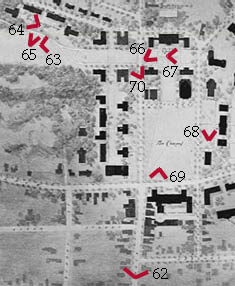
John Russell Pope's Master Plan for Dartmouth
Preface
A campus grows gradually over time, but its accretion is anything but random. Dartmouth's campus has been very carefully considered. The Beux-Arts trained architect John Russell Pope, who created a plan for Yale in 1919, created a master plan for Dartmouth in 1922-1923.
Dartmouth and Yale recognized Pope's influence in utterly different ways. Yale's Corporation decided to carry out the Pope plan beginning in 1920 and hired consulting architect James Gamble Rogers to design the buildings. Though the plan changed under Rogers, it still set the direction for the school for decades and was essential in determining Yale's present appearance. The school recognized Pope for his work on its first comprehensive plan, awarding him an honorary degree in 1924, as Yale's site Building a University explains.
Dartmouth also set its own architect to modify and carry out the plan Pope created for it. Jens Frederick Larson of the firm Larson & Wells became the school's most prolific designer, with Baker Library and Tuck Mall as the most prominent results. Working with Larson & Wells, Pope designed the 1922-23 Russell Sage Hall as one of the first elements of his plan. Beyond that building, Pope's influence on the campus was only indirect. The school seems to have sounded little fanfare for the architect at the time, and today virtually no recognition of Pope's role exists. In 1928 Jens Larson received an honorary MA from Dartmouth, along with Charles Platt, who consulted in 1928-1929 on the planning of Carpenter Hall, Sanborn House, and Tuck Mall.
The celebrated draftsman Otto Eggers illustrated Pope's various university plans. Together the Dartmouth plan and renderings of some of the proposed buildings made up a series of ten plates in the 1925 Architecture of John Russell Pope, vol. I. Pope would later design the Jefferson Memorial and the National Gallery of Art in Washington among many other buildings.
Locator
 |
Detail of Plate 61, arrows added.
Index and
Comment
Sources
- Bedford, Steven Michael. John Russell Pope: Architect of Empire. New York: Rizzoli, 1998.
- Pope, John Russell. The Architecture of John Russell Pope, vol. 1. New York: William Helburn Inc., 1925. Plates 61-69.
- Riorden, Elizabeth: "The Campus Plans of John Russell Pope." Precis. Columbia Graduate School of Architecture and Planning, 1981.
- Two of these plates also appear on the American Memory site of the Library of Congress:
- Plate 62 Bird's eye view
- Plate 65 Approach to dormitories from the Drive
-
- Pope's designs for Yale appear in a Yale University Archives 300 site called Building a University.
- Short biographical entry on John Russell Pope from MacMillan Encyclopedia of Architects.
- Pope's designs for Yale appear in a Yale University Archives 300 site called Building a University.

